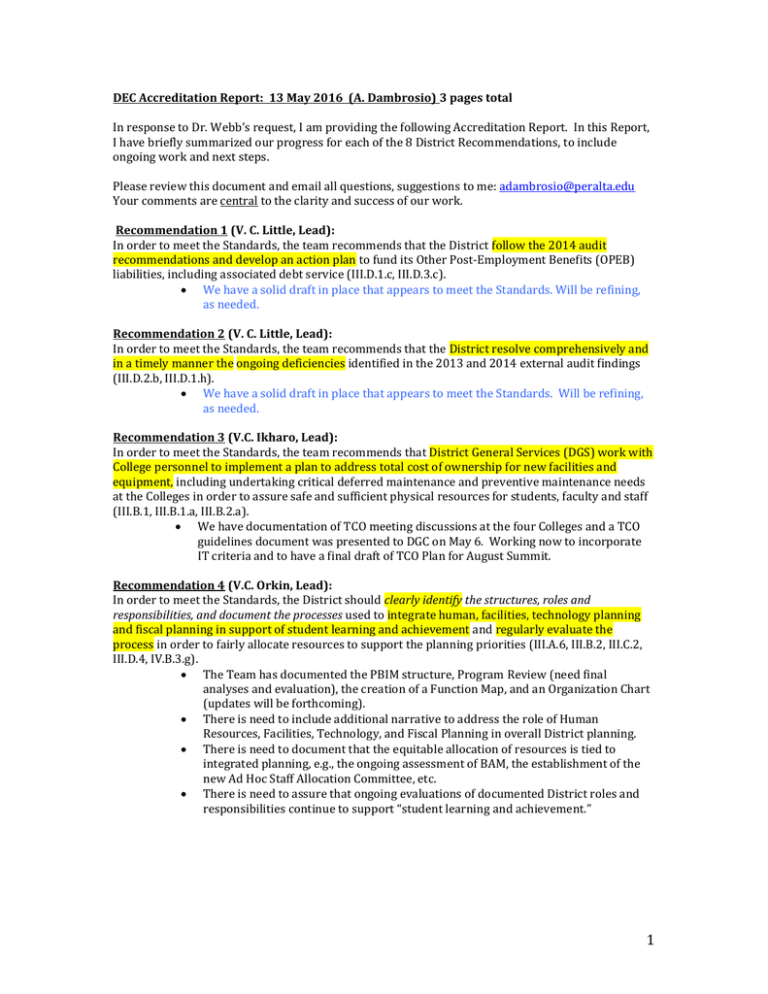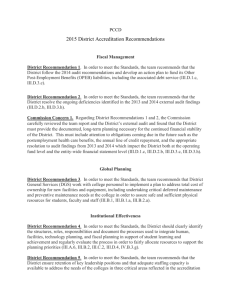DEC Accreditation Report 5-13-16
advertisement

DEC Accreditation Report: 13 May 2016 (A. Dambrosio) 3 pages total In response to Dr. Webb’s request, I am providing the following Accreditation Report. In this Report, I have briefly summarized our progress for each of the 8 District Recommendations, to include ongoing work and next steps. Please review this document and email all questions, suggestions to me: adambrosio@peralta.edu Your comments are central to the clarity and success of our work. Recommendation 1 (V. C. Little, Lead): In order to meet the Standards, the team recommends that the District follow the 2014 audit recommendations and develop an action plan to fund its Other Post-Employment Benefits (OPEB) liabilities, including associated debt service (III.D.1.c, III.D.3.c). We have a solid draft in place that appears to meet the Standards. Will be refining, as needed. Recommendation 2 (V. C. Little, Lead): In order to meet the Standards, the team recommends that the District resolve comprehensively and in a timely manner the ongoing deficiencies identified in the 2013 and 2014 external audit findings (III.D.2.b, III.D.1.h). We have a solid draft in place that appears to meet the Standards. Will be refining, as needed. Recommendation 3 (V.C. Ikharo, Lead): In order to meet the Standards, the team recommends that District General Services (DGS) work with College personnel to implement a plan to address total cost of ownership for new facilities and equipment, including undertaking critical deferred maintenance and preventive maintenance needs at the Colleges in order to assure safe and sufficient physical resources for students, faculty and staff (III.B.1, III.B.1.a, III.B.2.a). We have documentation of TCO meeting discussions at the four Colleges and a TCO guidelines document was presented to DGC on May 6. Working now to incorporate IT criteria and to have a final draft of TCO Plan for August Summit. Recommendation 4 (V.C. Orkin, Lead): In order to meet the Standards, the District should clearly identify the structures, roles and responsibilities, and document the processes used to integrate human, facilities, technology planning and fiscal planning in support of student learning and achievement and regularly evaluate the process in order to fairly allocate resources to support the planning priorities (III.A.6, III.B.2, III.C.2, III.D.4, IV.B.3.g). The Team has documented the PBIM structure, Program Review (need final analyses and evaluation), the creation of a Function Map, and an Organization Chart (updates will be forthcoming). There is need to include additional narrative to address the role of Human Resources, Facilities, Technology, and Fiscal Planning in overall District planning. There is need to document that the equitable allocation of resources is tied to integrated planning, e.g., the ongoing assessment of BAM, the establishment of the new Ad Hoc Staff Allocation Committee, etc. There is need to assure that ongoing evaluations of documented District roles and responsibilities continue to support “student learning and achievement.” 1 Recommendation 5 (V.C. Largent, Lead): In order to meet the Standards, the team recommends that the District ensure retention of key leadership positions and that adequate staffing capacity is available to address the demands of three critical areas reflected in the accreditation standards: institutional effectiveness and leadership, institutional research, and financial accountability and management (III.A.2, III.A.6). We continue to document the District’s review of adequate staffing. We are working to tie the retention of key leadership to effective Institutional leadership, e.g., Board and Management Retreats, June Management Academy, and ongoing management and staff training. We need to continue to document how Institutional Research and financial accountability/management goals are linked to integrated District Planning. We need to continue to document that we have mechanisms for ongoing evaluation of staffing needs and the retention of key leadership positions. Recommendation 6 (V.C. Orkin, Lead): In order to meet the Standard, the team recommends that the District clearly delineates and communicates the operational responsibilities and functions of the District from those of the Colleges and consistently adheres to this delineation in practice; and regularly assesses and evaluates District role delineation and governance decision-making structures and processes to assure their integrity and effectiveness in assisting the Colleges in meeting educational goals (IV.B.3). We are documenting changes made to the Program Review process (we are awaiting final Program Review summary and evaluation). We have documented the 2015 Customer Satisfaction Survey results (additional analyses are needed to strengthen Action Plans for improvement of some District Service areas). We are documenting how we have strengthened the District’s allocation of resources, e.g., the addition of an Ad Hoc Staff Allocation Committee, the ongoing assessment and revision of BAM, and the District Reorganization (this Recommendation overlaps with Recommendation 4). We have included the newly created Function Maps and Organization Charts (each document will need updating and assurance that Colleges concur). We need to document ongoing evaluations and the District’s assistance in the improvement and effectiveness of the Colleges’ educational goals. Recommendation 7 (Chancellor Laguerre, Lead): In order to meet the Standards, the team recommends the Governing Board adhere to its appropriate role. The Board must allow the Chancellor to take full responsibility and authority for the areas assigned to District oversight (IV.B.1, IV.B.1.a, IV.B.1.e, IV.B.1.j). A good delineation of functions structure is in place and much has been accomplished to date, e.g., the selection of a new Chancellor, renewed goals and enhanced collaboration between the Chancellor and the Governing Board. Specific steps are in motion for GB to continue to adhere to its appropriate role, e.g., GB Retreat, Chancellor communications, and ongoing evaluations. Recommendation 8 (V. C. Little, Lead): In order to meet the Standards, the team recommends that the District systematically evaluate the equitable distribution of resources and the sufficiency and effectiveness of District-provided services in supporting effective operations of the Colleges (IV.B.3.b, IV.B.3.c, III.D.1.a, III.D.1.b, III.D.1.h). We are currently documenting what is in place at PCCD that pertains to the equitable distribution of resources and are taking the necessary steps to examine how we can improve these equitable distribution processes. Again, the review and refinement of BAM is central to satisfying the Recommendation and to meeting the ACCJC Standards. 2 There is more work to be done to tie “equitable distribution of resources” to Institutional planning and ongoing assessment and improvement such that the equity is more readily operational. NEXT STEPS FOR ALL 8 DISTRICT RECOMMENDATIONS: 1.) Take action to continue to implement Action Plans as soon as possible such that we have ample opportunity to assess and to reevaluate our plans for ongoing assessment and refinement. 2.) Document evidence that we have used our assessments to affect change, i.e., improvements, particularly as outcomes pertain to the effectiveness of educating our students. 3.) Continue to document and post pertinent evidence to support our work. 4.) Afford greater care to record coherent minutes/notes of our discussions and actions (evidence documentation). Date all documents and include author(s) on documents. 5.) Continue to coordinate all Recommendations with the Colleges (I have put together a small group of two representatives from each College. This group has been working collaboratively since March and will continue to meet until the end of September to coordinate the District Recommendations and the College Follow-Up Reports. 6.) Continue to refine our Accreditation Web presence such that all information is more readily assessable and readable. Archive information, as needed. 3

